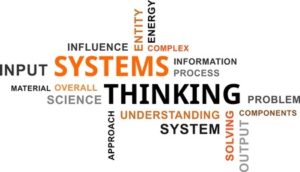Systems thinking

Systems thinking is a powerful approach for understanding and addressing complex, interconnected problems. By focusing on how the elements of a system interact, it enables us to see the bigger picture, identify leverage points for meaningful change, and develop more effective solutions. Unlike reductionist methods, systems thinking emphasises inter-relationships, diverse perspectives, and setting clear boundaries to navigate complexity.
This approach is particularly valuable for tackling wicked problems—challenges that no single actor or perspective can solve alone. As systems constantly evolve, systems thinking supports organisational and social learning, making it an essential tool for adaptive management and transformative change.
Start exploring with An introduction to systems thinking and systemic design, which offers a practical framework for applying these principles in real-world decision-making. Below, you’ll find curated resources, guides, and tools to help integrate systems thinking into your practice and address the challenges of a complex world.
Key resources on systems thinking
Systems Thinking and Practice: A Guide to Concepts, Principles and Tools
This 2023 guide by Jim Woodhill and Juliet Millican provides a practical introduction to systems thinking, exploring its theoretical foundations and tools. It highlights the need to shift from linear, reductionist approaches to more adaptive and systemic ways of working, offering insights into leadership and governance for addressing root causes of complex issues. It also offers links to additional resources and tools on systems thinking.
Developing a systems thinking guide
This 2023 guide by Michelle Irving et al. helps researchers and policymakers incorporate systems thinking into planning and interventions. Organised into four categories—system goals, beliefs, relationships, and resources—it offers a framework to drive systemic change and improve the impact of research and policy.
Working with Change: Systems approaches to public sector challenges
This 2017 OECD report explores the application of systems thinking in public governance. It offers a set of tactics for systemic change—such as connecting, framing, and prototyping—and includes case studies that demonstrate the practical application of these approaches in tackling public sector challenges.
Leverage points: Places to intervene in a system
Donella Meadows’ classic article identifies nine key leverage points for driving meaningful change in systems, offering timeless insights into how and where to intervene effectively.
Overview of systems thinking
This short article by Daniel Aronson explains systems thinking with practical examples, such as integrated pest management. A complementary introduction, Systems Thinking in 25 Words or Less by Debra Lyneis, applies these ideas in primary and secondary school contexts.
Applications in sustainability and public policy
Systems Thinking: An introduction
This 2015 brief by Kimberly Bowman et al. introduces systems thinking in the context of international development. It emphasises designing adaptable programmes that account for changing contexts and engaging diverse stakeholders to create transformational solutions.
Systems thinking: Unlocking the Sustainable Development Goals
In this 2016 post, Stephanie Draper argues that achieving the SDGs requires a systemic approach. She outlines three levels of organisational action: aligning with others’ efforts, understanding goal interconnections, and delivering initiatives that model sustainability.
Tackling wicked problems : A public policy perspective
This 2012 paper from the Australian Public Service Commission examines the characteristics of wicked problems and offers insights into developing effective strategies for addressing them. It highlights the need for adaptive and collaborative approaches in policymaking.
Some introductory system concepts and tools
Introduction to systems thinking
Daniel Kim’s resource provides essential tools and concepts for applying systems thinking in organisations. It is designed to help practitioners visualise and address the complexity of dynamic systems. You can download the full introduction which aims to give you the language and tools you need to start applying systems thinking principles and practices in your own organization.
Learn about systems thinking
The Australian Partnership Prevention Centre offers a curated collection of systems thinking resources for beginners and experienced practitioners, focusing on applying these ideas in research and practice.
Systems archetypes
Daniel Kim’s guide introduces nine common systems archetypes, which reveal recurring patterns of system behaviour. These archetypes serve as diagnostic tools for understanding system dynamics, complemented by Leyla Acaroglu’s 2017 reflections on positive social archetypes in systems dynamics. (See also the ISEE guide – Applying Systems Thinking and Common Archetypes to Organizational Issues).
Systems thinking: a means to understand our complex world
Linda Booth Sweeney introduces key systems concepts, including feedback loops, temporal delays, and system behaviour, offering practical tools for understanding complexity.
Courses in systems thinking
Open University – Systems thinking (free courses)
The Open University provides free courses exploring systems thinking, including Systems Thinking in Practice and Systems Diagramming. Other courses focus on specific areas like environmental management, sustainability, and IT systems.
More information on tools and methodologies to implement systems thinking can be found through the linked LfS pages on systemic design, systems thinking tools and conceptual modelling. You may also be interested in related pages such as supporting constructive practice change, and particularly the page on strategic planning.